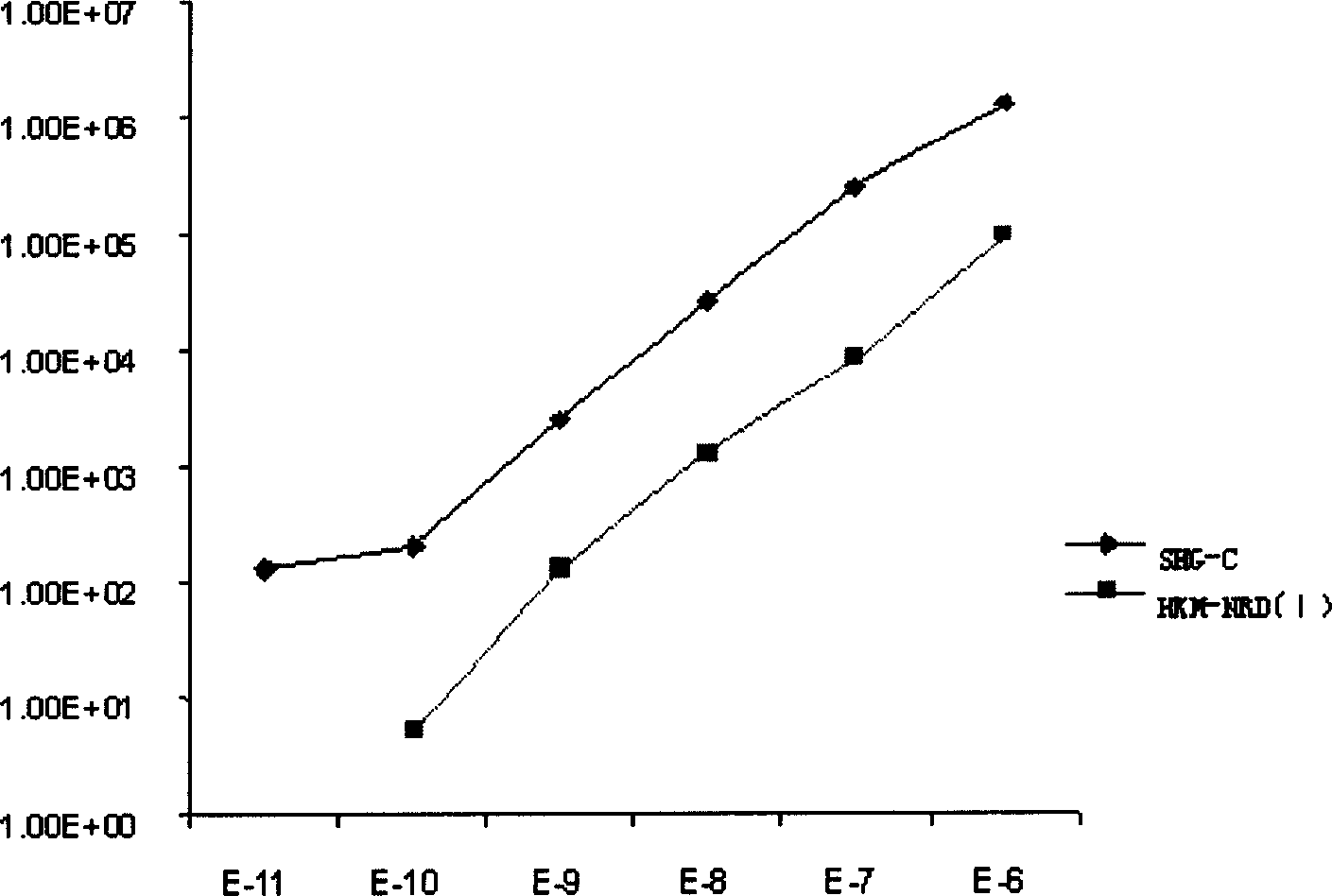Kit for anti-interference quick detection of microbe quantity by bioluminescence method
A technology for detecting the number of kits and microorganisms, applied in the biological field, can solve the problems of high detection cost and unapplied application.
- Summary
- Abstract
- Description
- Claims
- Application Information
AI Technical Summary
Problems solved by technology
Method used
Image
Examples
Embodiment 1
[0028] Example 1: Construction of bioluminescence rapid detection kit (luminescent reagent is FL04113)
[0029] (1) Pre-preparation of reagents
[0030] Luciferase protective agent: take 500mg trehalose, 500mg PEG6000 and 15mg BSA, dissolve in 10mL sterile distilled water, shake well and filter through a 0.22μm sterile microporous membrane to sterilize.
[0031] Standard ATP solution: Dissolve 55.1 mg of disodium salt A-2383 from Sigma in 10 mL of sterile distilled water to make a concentration of 1×10 -2 mol / L, packed in 1.5ml sterile centrifuge tubes, 0.1ml per tube.
[0032] Acellular ATP remover AP: its specific composition and production process is to use containing 50mmol / L Tris-HCl, 10mmol / LMgSO 4 , 1mmol / L EDTA, 1mg / mL BSA, pH6.8 buffer to prepare pyrophosphatase to a concentration of 5mg / ml, and filter through a 0.22μm sterile microporous membrane.
[0033] Microbial cell ATP extract E c : Add 20g TritonX-100, 2.0g CTAB, 2.0gDMSO, 0.05g EDTA, 0.05g MgSO per liter ...
Embodiment 2
[0040] Example 2: FL04113 ATP bioluminescent standard ATP curve
[0041] In the 0.5mL system on board the Shanghai Shangli bioluminescent instrument SHG-C and the luminescent instrument HKM-NRD (1) developed by Guangdong Kai Microbial Technology Co., Ltd., the detection standard concentration range is 10 -12 ~10 -6 mol / L ATP luminescence value, the detection system is 0.1mL FL+0.1mL standard ATP+0.3mL GB, and make a logarithmic curve and linear regression equation, the results are shown in Table 1 and attached figure 1 .
[0042] It can be seen from Table 1 that: on the SHG-C luminometer for luminescence detection, when the ATP concentration is 10 -10 ~10 -6 When mol / L, the linearity is better, and the regression curve in the 0.5mL luminescence system is Lg[ATP]=-12.4792+1.0374LgΔCPM, R=0.9977, n=5; on the HKM-NRD (I) luminometer, when ATP concentration at 10 -10 ~10 -6 The linearity is better at mol / L, and the regression curve is Lg[ATP]=-10.8382+0.9547LgΔCP6S 1 , R=0....
Embodiment 3
[0044] Example 3: Luminescent detection of yeast artificial samples (SHG-C)
[0045] (1) Luminescence detection on SHG-C
[0046] Saccharomyces cerevisiae samples were detected on SHG-C in a 0.5mL system, and the result of artificial yeast sample plate culture was 1.44×10 7 cfu / mL (stock solution is abbreviated as Y0), detection system: 0.1mL FL+0.1mL standard ATP or H 2 O sample + 0.3mL GB, see Table 2 for the luminescence detection results.
[0047] sample
Luminescence detection
CPM
ΔCPM
LgΔ
CPM
Lg[ATP]
[ATP]mol /
ml
conversion cell
Number of cells / ml
h 2 o
Standard ATP
Y0
10 -1 Y0
10 -2 Y0
10 -3 Y0
10 -4 Y0
3472
241452
1096208
144266
19182
5020
3753
1092736
140794
15710
1548
281
6.0385
5.1486
4.196
3.190
2.4487
-6.2328
-7.1380
...
PUM
| Property | Measurement | Unit |
|---|---|---|
| Spore count | aaaaa | aaaaa |
Abstract
Description
Claims
Application Information
 Login to View More
Login to View More - R&D
- Intellectual Property
- Life Sciences
- Materials
- Tech Scout
- Unparalleled Data Quality
- Higher Quality Content
- 60% Fewer Hallucinations
Browse by: Latest US Patents, China's latest patents, Technical Efficacy Thesaurus, Application Domain, Technology Topic, Popular Technical Reports.
© 2025 PatSnap. All rights reserved.Legal|Privacy policy|Modern Slavery Act Transparency Statement|Sitemap|About US| Contact US: help@patsnap.com



